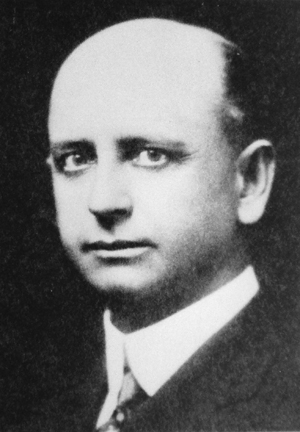
October 21, 2014
AASHTO Presidential Profile: William S. Keller, Alabama

A mere six years after AASHO was established, William Simpson Keller was elected the new president of the association at its annual meeting in Washington, D.C., in December 1920. Keller, the state highway engineer of Alabama, had also been one of the founders of AASHO and would prove to a major force in the association during its first decade of existence.
Keller assumed the presidency in a period that AASHO Executive Secretary William Colfax Markham later characterized as “trying times when some men lost sight of the real national needs for highway development.” That was the post-World War I era, in which the association sought to build upon what had begun with the pioneering Federal-aid Road Act of 1916.
Keller was born in the city of Tuscumbia, in Colbert County in northwestern Alabama, at his family’s homestead Ivy Green on Feb. 20, 1874. His father, Arthur Henley Keller, served as a captain in the Confederate Army during the Civil War and also was a long-time newspaper editor. William Keller’s mother, Sarah E. “Sallie” Simpson Keller, died just two days before his third birthday. Arthur Keller subsequently married Catherine Everett Adams.
Other members of William Keller’s family tree included his paternal grandmother’s second cousin Robert E. Lee. That towering military figure, however, was not Keller’s only famous relative. One of his half-siblings from his father’s second marriage was Helen Keller, the renowned deaf and blind author and social activist whose struggles and example have inspired similarly disabled individuals as well as many others worldwide.
William Keller’s own lifework started in earnest in 1893 when he graduated from the University of Alabama with a bachelor of civil engineering degree.
Over the next several years, his career as a civil engineer included working as county surveyor in his native Colbert County; assistant engineer for Shiloh National Military Park spanning both Tennessee and Mississippi; chief engineer for Madison County, Tennessee; and the engineer in charge of road construction in Dallas County, Tennessee. In addition, Keller worked for the U.S. Office of Public Roads during 1908-09.
Keller’s leadership in roads development grew a great deal more in April 1911 when he was appointed head of the newly formed Alabama State Highway Department. The creation of that agency was fueled by the Good Roads Movement that had taken firm root in Alabama by that time.
In his pioneering role as state highway engineer, Keller sought to continue and strengthen those efforts to improve and expand Alabama’s roads network. Between 1911 and 1914, for example, he traveled extensively throughout the state and personally mapped out a number of potential routes to be built statewide.
Keller, who went by the nickname “Simp,” further advanced those efforts in 1915 when he published a map of three state highways that would ultimately become the basis of Alabama’s federal-aid road system.
As confirmed in a 1926 report on the Alabama State Highway Department, however, that agency’s overall work early on “was principally one of education in trying to persuade the counties to construct roads along economical lines and use to advantage the local materials were easily accessible.” As that report also noted, “the amount of money was pitifully small with which to construct roads, but it served well its purpose of setting examples with location by skilled engineers and proper methods of surfacing with different kinds of materials.”
Alabama’s road-building projects and capacities received a considerable boost with passage of the landmark 1916 law and the federal-state partnership in highway construction that it established. Keller pursued and promoted that type of partnership both for Alabama and elsewhere through his ever-increasing collaboration with likeminded fellow state highway officials throughout the nation.
As existing communications verify, Keller was among a handful of those officials who were part of the discussion during 1914 to form an association to better advocate for state-level highway priorities.
Keller was among those who met at the Georgian Terrace Hotel in Atlanta, Georgia, in November 1914 to agree to form such an association. It was Keller himself who issued the call at that meeting for his fellow state highway officials to gather the following month in Washington, D.C., to formally establish AASHO.
As a founder of AASHO, Keller was very much a pivotal participant during its formative years and a staunch proponent for the association’s goals. He assumed a seat on the AASHO Executive Committee, reaching the zenith of that service with his selection as president.
Keller’s time as president focused on stronger road construction capabilities and federal-state cooperation. “Another year has been added to the life of the Association, a year that in no way has been uneventful,” he said at the end of term.
“Without in any way attempting to dictate the road laws of the Government, but acting solely with a desire to strengthen rather than weaken existing laws, we have given the committees of Congress such data and information as were at our disposal.”
The cornerstone of Keller’s tenure as president was enactment of the Federal Aid Highway Act of 1921. That measure, which was signed into law by U.S. President Warren G. Harding on Nov. 9 of that year. The law resulted from the advocacy of AASHO and other stakeholders for improved financing provisions for highway construction and other issues not adequately addressed in the 1916 act, while retaining the basic principles of the federal-state partnership.
The 1921 law launched an unprecedented period of work and improvements on the nation's highways throughout the remainder of that decade. Annual federal authorizations remained at $75 million through 1930. “Whether the new law is satisfactory to all States or not, we are compelled to admit that it does please a large majority and that is the best we can hope for,” said Keller in his own assessment of the far-reaching measure at the AASHO annual meeting in Omaha, Nebraska, in December 1921.
Keller also proved to be a staunch proponent of highways beautification. “Should we not also in our haste to build high-class, serviceable roads pause and give thought to the aesthetic phase of it?” he asked in a series of rhetorical questions about this issue at the 1921 annual meeting.
“Should we confine our attention solely to the grade, surface, structures and gutters? Should we not look ahead to the future and visualize our roads and their surroundings, painting in our minds a pleasing picture of a road with easy curves bordered with grassy slopes and stately trees?”
After stepping down as president, Keller remained active and engaged in both AASHO’s activities and as state highway engineer of Alabama until his death on Sept. 9, 1925, at the age of 51 in Montgomery, Alabama.
“He died in the prime of life, but his years had been full of accomplishment,” said Executive Secretary Markham in his remarks on Keller. “Of modest demeanor, few knew of his many deeds. His going leaves a vacant seat in our midst, there is a tug at the heart strings, but his life is an inspiration to all those who are willing to devote their days for the public good.”












